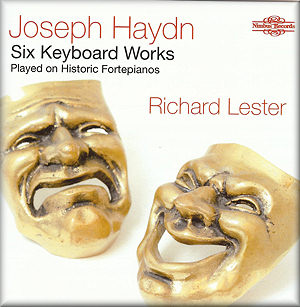 |
 |
|

Buy
through MusicWeb
from £12.00 postage paid.
Musicweb
Purchase button
|
Franz Joseph
HAYDN (1732-1809)
Sonata in D major, Hob. XVI:37 (ante 1780) [11:53]
Sonata in G major, Hob. XVI:27 (ante 1776) [11:37]
Sonata in C major, Hob. XVI:35 (ante 1780) [13:32]
Sonata in F major, Hob. XVI:23 (1773) [15:10]
Parthia in E-flat major, Hob. XVI:Es3 (attrib) (c.1764) [8:26]
Divertimento in A-flat major, Hob. XVI:46 (ante 1788) [13:35]
 Richard Lester (fortepiano) Richard Lester (fortepiano)
rec. March 2008.
 NIMBUS NI 5847
[74:23] NIMBUS NI 5847
[74:23]  |
|
|
I mean no disrespect to Richard Lester - nor of course to Haydn! - if I say that one of the most interesting aspects of this disc lies in the instruments used. In the first four pieces in his programme Lester plays a fortepiano by Johann Schantz, the manufacture of which is thought to belong to about 1795. Schantz was born in South Bohemia in 1762; Haydn thought well of the instruments he produced in his workshop in Vienna. We know that he acquired a fortepiano from Schantz in 1788, and in a letter of June 1790 - to his patroness Maria Anna von Genzinger - Haydn wrote 'it is only a pity that your Grace doesn't own a Schantz fortepiano, on which everything is better expressed'. In another letter to the same lady he compared Schantz's instruments favourably to those made by Walter, observing that Schantz's fortepianos 'have a quite special lightness and are very nicely finished'. It was of instruments made by Johann's brother Wenzel that Haydn was talking in these letters, but Johann took over his brother's workshop and his instruments are the nearest we have to those of Wenzel. The instrument played here is in the collection of the Holburne Museum in Bath. With a range of five octaves, it has two knee levers (a damper lift and a moderator) and a hand stop. The sound is sonorous but quite crisp, without any harshness, good in both bass and tenor and with a bright sound in the treble.
The last two items in the programme are played on what is probably a North Italian instrument of 1790, or possibly earlier, of unknown manufacture. Discovered in semi-ruined condition, the instrument was restored by Michael Cole. Again there are two knee levers (one for treble one for bass) and a moderator operated by a stop above the keyboard. The instrument has a particularly clear articulation, heard to especially good effect in the Divertimento which closes this disc.
Lester is a very accomplished player, most often heard seated at the harpsichord. Indeed, there is perhaps something of the harpsichordist about his playing, his control of rhythmic patterns and contrasts being particularly striking, his range of tonal colour and dynamic variation perhaps a little less so. These are fine performances, nevertheless, clear and purposeful at all times, entirely in the spirit of the galant manner. These are performances full of respect and enthusiasm for Haydn's keyboard writing. Lester imposes his own personality rather less than many a modern performer - individual listeners may find that either a limitation or a strength. The more I listened, the more I found it a pleasing strength. We are lucky at the moment in the number of fine performances of Haydn's keyboard works which are available, on a variety of instruments and from fair variety of perspectives. Andreas Staier, Ronald Brautigam, Marc-André Hamelin, to name but a few, are helping us to understand what a fascinating body of music this is, and how long its qualities have been underestimated. Richard Lester's recital - on these two fascinating instruments - has its own role to play in that process of reassessment.
Glyn Pursglove
|
|

